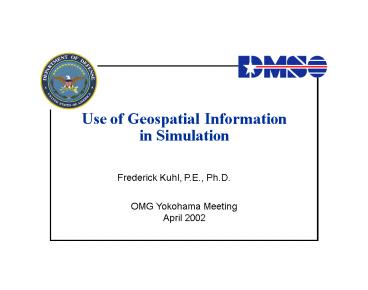Use of Geospatial Information in Simulation - PowerPoint PPT Presentation
1 / 13
Title:
Use of Geospatial Information in Simulation
Description:
... of climate change on fish and wildlife habitat in the San Francisco Bay area. ... layers for a four-county study area in the Delaware River basin, Kansas, are ... – PowerPoint PPT presentation
Number of Views:143
Avg rating:3.0/5.0
Title: Use of Geospatial Information in Simulation
1
Use of Geospatial Informationin Simulation
Frederick Kuhl, P.E., Ph.D.
OMG Yokohama MeetingApril 2002
MITRE
2
Agriculture Combines GIS With Various Simulations
- U. Illinois sponsors a variety of applications of
GIS to natural resource conservation - A farmer's introduction to the application of GIS
to precision agriculture data - Illinois Watershed Management Clearinghouse
grassroots organizations promoting management of
watersheds - The Dynamic Integrated Urban Expansion Model An
Ecological Approach - See http//web.aces.uiuc.edu/sriit/water.asp
3
USDA Transforms Standard GIS Data for Farm
Simulation Inputs
- Farm Spatial Data Management System (FSDMS)
transforming data from a georectified map or
nongeorectified image format to a data format
acceptable to GPFARM - GPFARM farm/ranch decision support system in
which agricultural strategies can be developed
and tested - site-specific management
- socio-economic analysis
- environmental impacts
- site database generation
- risk analysis from which alternative
- Uses data contained in ARCVIEW
- See http//gpsr.ars.usda.gov/products/fsdms.htm
4
Geospatial Data Combines with Visualization for
Land Care Decisions
- RMIT University (Australia)
- Project to combine geospatial data with visual
simulation of landscapes - reduce damage wrought by bushfires
- record the early outbreak of pests in crops
- forecast the occurrence of dryland salinity
- "Through the convergence of a range of
technologies, including the geospatial sciences
and visual simulation, fire fighters will be
able, in much quicker time and with greater
accuracy than was available, to see a fire
landscape in real time on a virtual reality
screen and decide the best methods to effectively
deploy fire fighting resources" - http//www.rmit.edu.au/
5
USGS Funds Applications of Geospatial Data to
Biological Simulations
- Effects of climate change on fish and wildlife
habitat GIS digital data layers are being used
with simulation models on sea-level rise to
predict the effects of climate change on fish and
wildlife habitat in the San Francisco Bay area. - Developing a three-dimensional mountain
climatology and validating a spatially explicit
microclimate simulation model - GIS digital data layers for a four-county study
area in the Delaware River basin, Kansas, are
being used with soils data and a sediment yield
model to simulate reductions in sediment yields
from lands converted from crops over a 10-year
period - http//biology.usgs.gov/geotech/documents/applicat
ions_and_infrastructure/highlights/mesc.html
6
Geospatial Information Should Be Used in Urban
Planning
- Very crude GIS was used in 1970s in planning and
simulating urban transportation - Road needs studies
- Carpooling
- Google turned up nothing, surprisingly
7
Geospatial Information Crucial to Military
Simulation
- All military simulation depends on geospatial
information - Scenario, i.e. initial conditions, must be
created for analysis or training simulation - Synthetic Environment Data Representation and
Interchange Specification (SEDRIS) - long-term effort, begun 1994
- driven initially by simulation
- other applications
- Standards through ISO/IEC Joint Technical
Committee 1 (Information Technology) Subcommittee
24 (Computer Graphics and Image Processing)
Working Group 8 (Environmental Representation) - Implementations through SISO, www.sisostds.org
- www.sedris.org
8
SEDRIS Main Principles
- Goal is to support
- representation of environmental data
- interchange of environmental data sets
- all environmental domains ocean, terrain,
atmosphere and space
9
SEDRIS Core Technologies for Description of
Environmental Data
- SEDRIS Data Representation Model (SDRM)
- 360 UML classes that allow the description of any
environmental data, regardless of resolution,
domain, or density - Environmental Data Coding Specification (EDCS)
- What something is, what are its characteristics,
what units are used to measure those
characteristics - SEDRIS data types go beyond cartographic domain,
so SEDRIS began with FACC standard but expands
it, maintains a mapping to FACC - Spatial Reference Model (SRM)
- 151 spatial reference frames, in addition to a
large set of object reference models (earth
reference models such as ellipsoids) - Associated sw provides fast, accurate conversions
10
SEDRIS Core Technologies for Interchange of Data
- SEDRIS interface specification (API)
- API encapsulates functionality needed to produce
and consume SEDRIS transmittals - ANSI C (for maximum portability), implemented in
C - Reference implementation on Unix (SUN, SGI, IBM),
Win9x and NT (Intel-based machines), Linux - SEDRIS Transmittal Format (STF)
- Platform-independent format designed to support
the full capabilities of the SDRM - File-based storage system, as space efficient as
possible
11
State of SEDRIS Acceptance
- ISO/IEC acceptance of core standards is
progressing - Mandated by U.S. Army STRICOM as format for
environment data - Used by all U.S. DoD Army and Joint simulations
- Favorably evaluated by U.K. MoD and NATO
12
Relation of SEDRIS to Commercial Packages
- SEDRIS, like many commercial tools, imports and
exports various data formats - Import DTED- and VPF-formatted data to STF
- Export STF to MS-unique formats
- Work underway
- ESRI ArcObject "compliant" applications to
export/import data (mainly vector) for STF - FME (vector, grid) exporter/importer for STF
- Data models SEDRIS supports only EDCS, mappings
between the EDCS other Data Dictionaries "out
there - MS database-building community often uses
commercial GIS technology to "clean" vector data
from a variety of sources
13
Summary
- Simulation domains involving geographic entities
all use GIS, not surprisingly - Agriculture
- Biology
- Military
- Urban analysis and planning doesnt seem to be
represented - There is a U.S. military standard for exchange of
environmental data, SEDRIS

